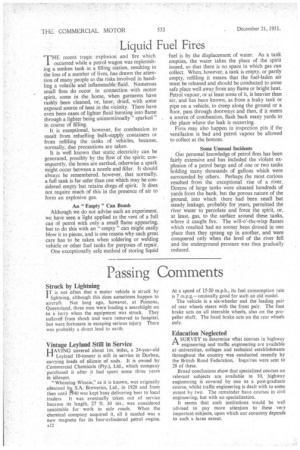Liquid Fuel Fires
Page 24

If you've noticed an error in this article please click here to report it so we can fix it.
THE recent tragic explosion and fire which occurred while a petrol wagon was replenishing a sunken tank at a filling station, resulting in the loss of a number of lives, has drawn the attention of many people to the risks involved in handling a volatile and inflammable fluid. Numerous small fires do occur in connection with motor spirit, some in the home, when garments have rashly been cleaned, or, later, dried, with some exposed source of heat in the vicinity. There have even been cases of lighter fluid bursting into flame through a lighter being unintentionally " sparked " in course of filling.
It is exceptional, however, for combustion to result from refuelling bulk-supply containers or from refilling the tanks of vehicles, because, normally, due precautions are taken. It is well known that static electricity can be generated, possibly by the flow of the spirit; consequently, the hoses are earthed, otherwise a spark might occur between a nozzle and filler. It should always he remembered. however, that normally, a full tank is far safer than one which may be considered empty but retains dregs of spirit. It does not require much of this in the presence of air to form an explosive gas.
An " Empty " Can Bomb Although we do not advise such an experiment, we have seen a light applied to the vent of a full can of petrol with only a small flame appearing, but to do this with an " empty " can might easily blow it to pieces, and is one reason why such great care has to be taken when soldering or welding vehicle or other fuel tanks for purposes of repair.
One exceptionally safe method of storing liquid fuel is by the displacement of water. As a tank empties, the water takes the place of the spirit issued, so that there is no space in which gas can collect. When, however, a tank is empty, or partly empty, refilling it means that the fuel-laden air must be released and should be conducted to some safe place well away from any flame or bright heat. Petrol vapour, or at least some of it, is heavier than air, and has been known, as from a leaky tank or pipe on a vehicle, to creep along the ground or a floor, pass through doorways and then, if it meets a source of combustion, flash back many yards to the place where the leak is occurring.
Fires may also happen in inspection pits if the ventilation is bad and petrol vapour be allowed to collect at the bottom.
Some Unusual incidents Our personal knowledge of petrol fires has been fairly extensive and has included the violent explosion of a petrol barge and of one or two tanks holding many thousands of gallons which were surrounded by others. Perhaps the most curious resulted from the exceptional rise of a river. Dozens of large tanks were situated hundreds of yards from the bank, but the porous nature of the ground, into which there had been small but steady leakage, probably for years, permitted the river water to percolate and force the spirit, or, at least, gas, to the surface around these tanks, where it caught fire. The will-o'-the-wisp flames which resulted had no sooner been doused in one place than they sprang up in another, and were conquered only when the level of the river fell and the underground pressure was thus gradually reduced.












































































